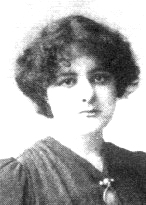Inghinidhe na hÉireann
|
Maud Gonne (1866-1953) developed strong nationalist convictions as a young woman. She was frustrated at being excluded as a woman from membership of cultural and political organisations in Dublin.
To protest against the visit of Queen Victoria to Ireland in 1900, she led a group of women who raised funds, obtained free gifts of confectionery and drinks and treated about 30,000 children in Phoenix Park, Dublin to a Patriotic Children's Treat.
|

Maud Gonne |
These women were reluctant to disband and set up a new organisation for women in October 1900 called Inghinidhe na hÉireann (Daughters of Ireland). Their aims were to encourage Irish language, Irish culture and Irish products and to discourage all that was English.
Their strong leanings towards nationalism with elements of feminism and socialism found expression in their paper Bean na hÉireann published 1908-1911 and edited by Helena Molony. They also ran classes for children and supported the provision of school meals for poor children.
Inghinidhe na hÉireann provided a platform for a host of talented women and men in theatre, literature, art and politics. They obtained male actors from the Celtic Literary Society to assist in the performance of tableaux vivants ('living pictures') which illustrated Irish legendary figures such as the Children of Lir and Queen Maeve. Members also wrote plays. Lady Gregory and W.B. Yeats (who was in love with Maud Gonne) wrote Cathleen Ní Houlihan which was first performed in 1902 with Maud in the lead, together with Deirdre, a play by Æ (George Russell). This collaboration merged into the Irish National Theatre and eventually led to the creation of the Abbey Theatre.
Inghinidhe members, as a women's group, did not want to stir up 'any sex antagonism between Irish women and Irish men.' They believed that 'when Ireland was free, women would be free.' They supported women's suffrage, but they objected to asking a 'foreign parliament' in Westminster for votes for women. Pointing to the admission of women to the Gaelic League and to Sinn Féin, they declared that they confidently trusted Irish men to treat women as their equals.
Sinn Féin, the first political party in these islands to admit women as full members, was founded in 1905. Inghinidhe members were voted on to the executive, including Jennie Wyse Power who was elected vice-president of Sinn Féin in 1911. Inghinidhe na hÉireann, in 1915, was admitted as a separate branch to Cumann na mBan, another women's organisation with nationalist aims which had been founded the previous year.
In the chain of organisations that transformed Irish national and feminine identities in the early years of the twentieth century, Inghinidhe na hÉireann was a significant link.
Questions
- Why did Maud Gonne organise a treat in the Phoenix Park for thousands of children in 1900?
- What were the aims of Inghinidhe na hÉireann?
- W.B. Yeats, in love with _____ ____, wrote a play called ___ ______ ____, which was first performed in _____ with ______ ____ in the lead.
- What was the policy of Inghinidhe na hÉireann with respect to women's suffrage?
- Why did Inghinidhe na Éireann see no need for 'sex antagonism'?
- Briefly discuss the importance of Inghinidhe na hÉireann.
Activities
- Make a poster for either the Patriotic Children's Treat or The Countess Cathleen.
- Write an article for Bean na hÉireann.
- Organise a class debate on the topic: 'That history has proved Inghinidhe na hÉireann justified in trusting Irish men to treat women as their equals.'
- Research the history of the foundation of the Abbey Theatre.
- Study Inghinidhe na hÉireann, Mary E. Butler and Jennie Wyse Power in Documents at the end of this section.
